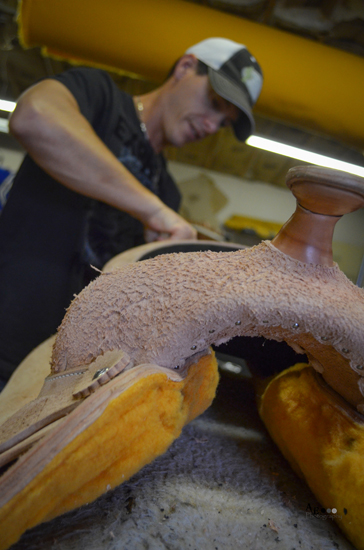
Joey Wenger crafting a work saddle
When the first saddle was created nearly 4,000 years ago there was no fancy tooling or black ostrich seat. Silver was still just kept in the rider’s pocket. In fact, those early creations were not much of a saddle at all, but merely a piece of animal hide or a scrap of cloth between the rider and the horse. As riding gained in popularity and horses became an integral mode of transportation, saddles evolved into more elaborate pieces of equipment.
By the 700s Moorish horsemen and warriors of the Dark Ages used saddles similar in shape and design as today’s western saddles. Complete with cantles, forks and stirrups, the saddles provided protection from attacking warriors and stability for the heavy armor. From the 1700s through the 1950s the western stock saddle evolved and soon sported new features specific to cattle work. Construction also improved providing added strength, durability and comfort.
Much has changed over the years but one thing remains the same. Saddles are still primarily made by hand and here four top makers explain how it’s done.
Despite the rise of mechanization, the top western saddle makers choose to continue making saddles largely by hand. Since the 1950s little has changed in the way saddles are made. “We still use nails and glue and hand stitch the parts of the saddle together,” says Joey Wenger, Wenger Saddlery in Mechanicsburg, Pennsylvania.
Each piece of leather is cut with little reliance on machinery. “The process has not really been automated,” says Phil Harris, Harris Leather and Silverworks, in State Road, North Carolina, “we use a clicking press that cuts out all the saddle parts one at a time. This really speeds up production and adds an element of uniformity.”
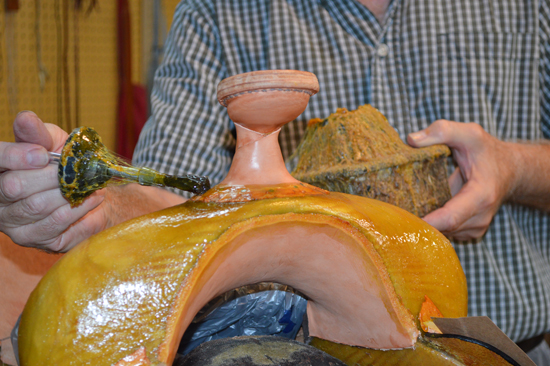
A pommel being glued at McLellands
Even when die-cut tools are used, not every piece can be mechanically cut. “Some pieces of leather can only be hand-cut and fitted to the tree,” says Rita Habighorst, Blue Ribbon Custom Tack, in Phoenix, Arizona.
There is not a square inch of a custom made saddle that isn’t handmade. The intricate designs on the skirting, fenders and other areas of the saddle are all hand-tooled. “Tools the size of a fountain pen are used to add the floral, acorn, roses and other patterns you see to the leather,” explains Ted McLelland, McLelland’s Saddlery, in Lake Worth, Florida.
While the basic process of saddle making has largely remained the same, modifications in seat shape, the arcs and angles of the trees and the shape of the fenders have been developed to provide riders with better feel, poising them for improved communication with their horse.
“We are constantly working to make the saddles do more for the horse and ride,” Harris says. Although close contact seats were standard among hunt seat riders, it was not until the early 1900s that the design was used in western saddles. “In 1991 we introduced the first close contact western saddle, which gives the rider a more well positioned seat and allows for more leg contact,” he says. Exhibitors at all levels and especially those chasing championship titles are always looking for a saddle that provides for direct, subtle cuing to their horse. “The flex fender, we introduced gives the rider the ability to subtly move the heel against the horse with minimal effort. The feature also takes the pressure off the rider’s knees,” he says.
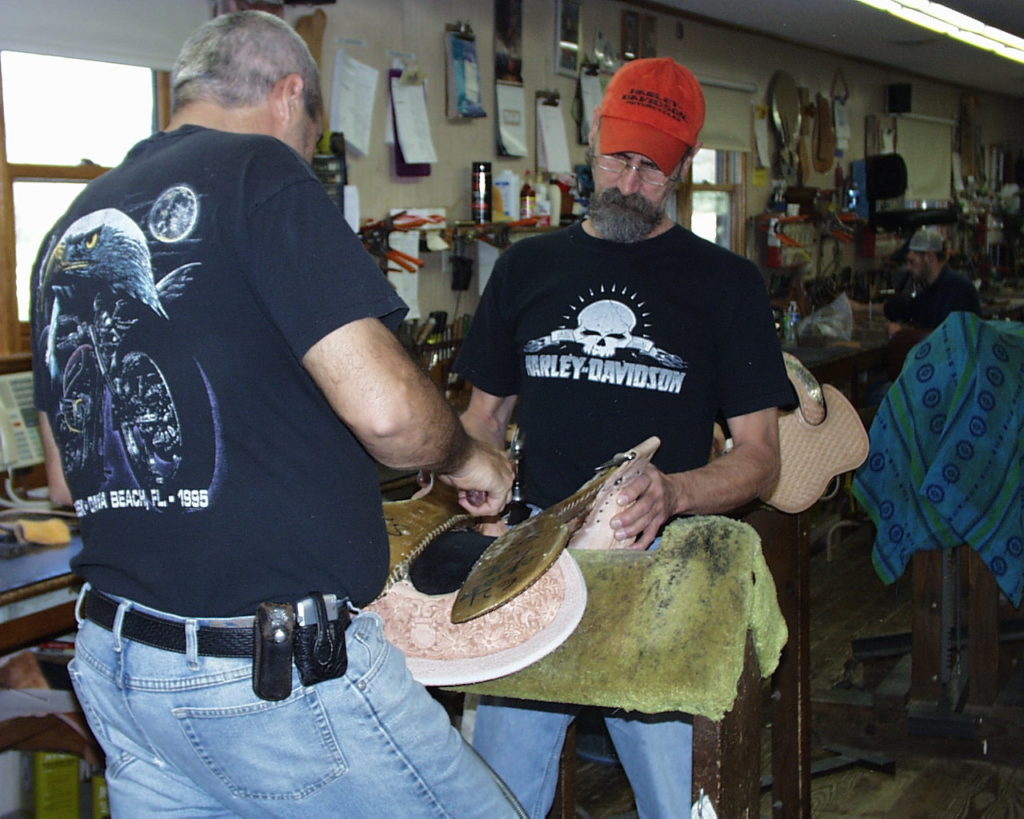
A saddle being assembled at Harris Leather and Silverworks
At the same time riders are looking for a saddle to improve their equitation and offer direct communication with their horse, they are more concerned with proper fit for their horse than in years past. “Riders are recognizing the importance of fit and performance more than ever,” Wenger says. Over the past 15 years, the body structure of the horse has changed as selective breeding has encouraged specialization. “We really focus on the shape and angle of the bars in our saddles because fit is everything,” he adds.
In general, the basic shape of the tree has remained the same, but the material used to build the tree has shifted from rawhide to fiberglass. “Fiberglass isn’t flexible like rawhide is, but if it is fit properly that doesn’t matter,” Wenger adds. The transition to fiberglass is attributed to availability and cost. “We still prefer to use rawhide, especially if we know a client will be really hard on their saddle, but fiberglass is also used quite a bit,” McLelland says.
Only two main tanneries are left in the United States. An abundant supply of top quality leather, but access to it is limited. “We have the ability to get top quality leather, but at a premium price because it’s being shipped to China,” Wenger says.
Rawhide is more challenging to work with, but is still considered superior to fiberglass by some saddle makers. “We have decided to build our own trees and we’re using rawhide,” he adds, “building them ourselves helps us control costs while allowing us to use the material we prefer.”
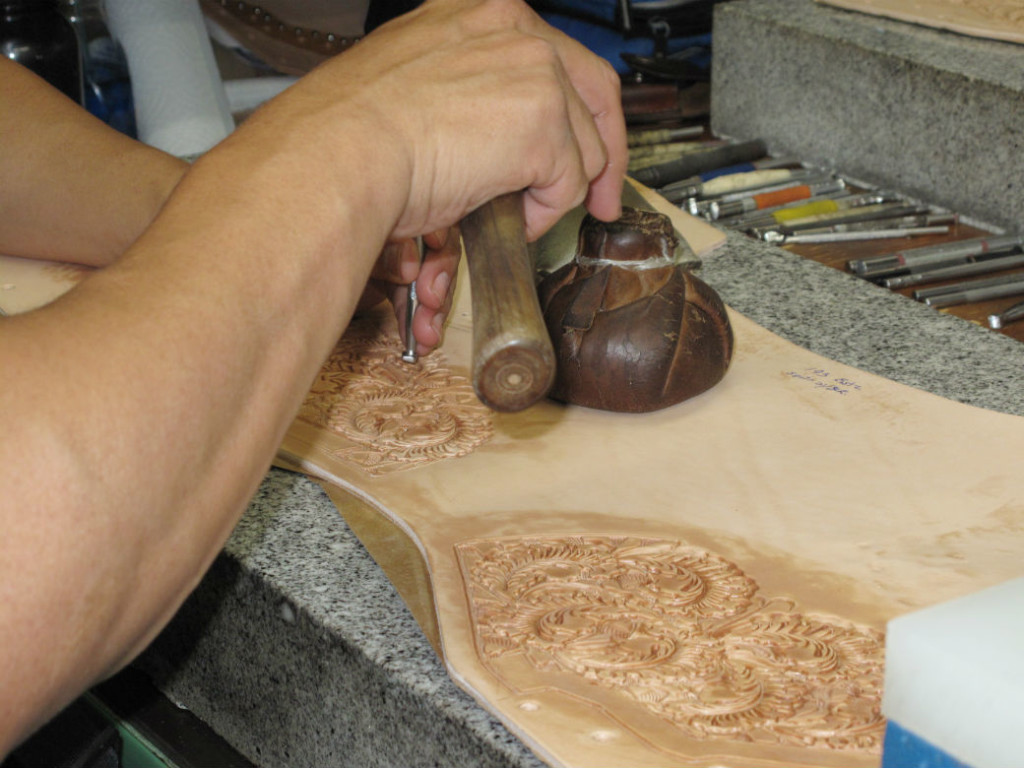
Some stamping at Blue Ribbon Custom Tack
Trendsetting
Undeniably, the outward appearance in the shape of the skirting, the color and the silver accents looks nothing like it did several decades ago. The trend has shifted away from dark colored saddles of the 80s to the light colored saddles popular now. Black saddles and dark accent pieces integrated into a light color saddle has seen a surge in interest in the last 10 years. “The outline of the saddles has changed over the years too,” Habighorst says. Skirting once rounded, is now most often square or angled.
Silver embellishments have also changed. Conchos, specifically heart shaped conchos, were the accent of choice in the 80s. Silver bedazzled with precious stones replaced conchos and saddles were dripping in silver. “The riders you used to see with saddles loaded with silver are now choosing saddles with less of it,” McLelland notes, “instead they are looking for detail in craftsmanship and the pattern of the tooling to set themselves apart from others.”
Until the 2000s it wasn’t uncommon for customers to purchase an in-stock saddle. “Now customers have their own ideas of what they want in tooling, silver, etc. and so we make a saddle custom for them and it is up to us to do our best to achieve the look they want. Customers are much more educated about saddles than they were in the 1980s and they are typically quite attuned to what they want in a saddle,” Habighorst says.
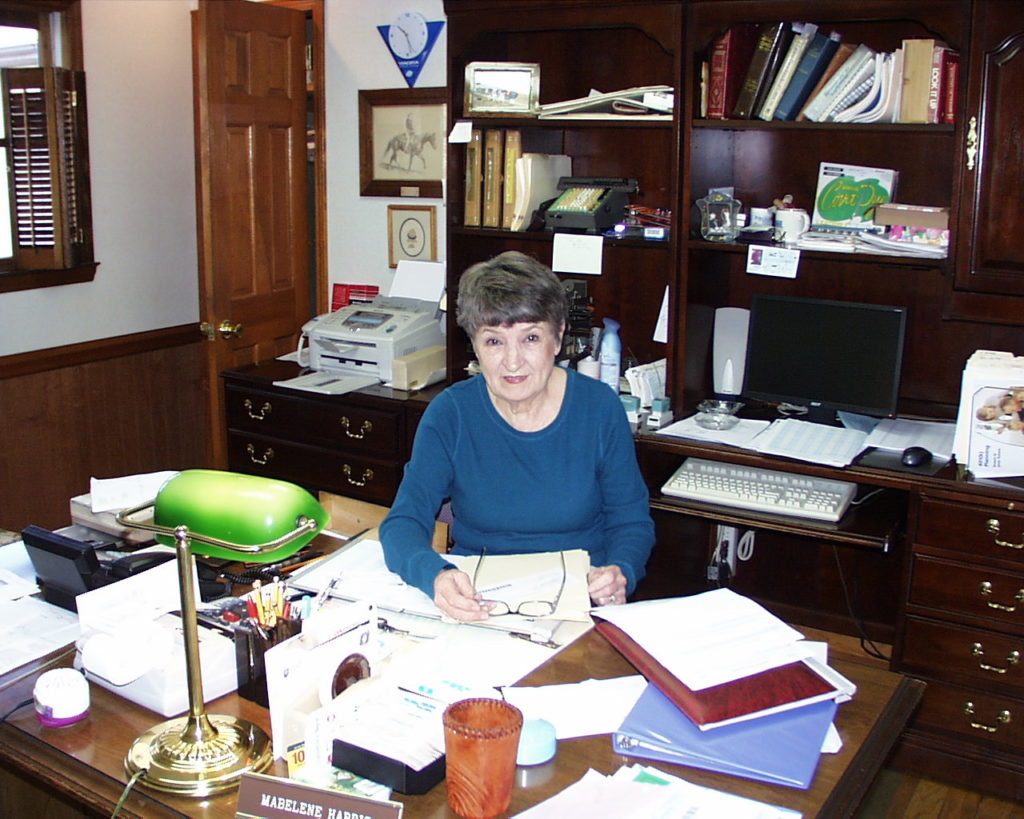
Mabelene Harris
Tradition of Generations
Longevity, a rarity in most industries, is commonplace among saddle makers. “I hired an employee to help me very early in my career. That person still works here. I believe he helped some on the very first saddle,” Harris says.
To achieve the level of quality and craftsmanship customers demand, it requires a skilled and steady hand. “We are fortunate that we have saddle makers who have been with us a long time,” Habighorst says, “one employee, who has since passed on, encouraged his two sons to come to work for us and they are still employed by us.”
At the end of the day, riders value the workmanship and quality they receive when purchasing a hand crafted saddles and often share their appreciation with up and coming horsemen and women.
“While I was at the AQHA Youth World Show, I had a family come to me and order a saddle for the youngest generation. We’ve now served three generations of the family. It makes me feel old, but it’s pretty neat to have the grandparents bringing their grandchildren to us for a saddle,” McLelland says.
About the makers:
Blue Ribbon Custom Tack – In the 1960s and 70s Vern and Rita Habighorst managed horse shows, which included ordering the awards. The awards never arrived on time or as ordered. Determined to offer better customer service, the couple founded an awards business. In 1981, the Habighorsts were invited to hand deliver trophies to the first AQHA show in England. On the flight home the couple decided to expand to include tack and hand crafted saddles. That first year five Blue Ribbon saddles were made and now the company produces between 350 and 380 saddles a year. For more information call Vern and Rita at 602-992-2145 or visit http://blueribboncustomtack.com/tack/buckles-and-belts.
Harris Leather and Silverworks – Founded by matriarch, Mabelene Harris, Harris Leather and Silverworks was established in the 1960s. Mabelene first tooled leather belts and purses and in 1982, son, Phil built his first saddle. The learning curve was steep and four saddles were made that year. Today, the company produces both show and work saddles. Family is still an important piece of the business. Many employees have been a part of the business for 20 years or more and they work alongside nine Harris family members. For more information call 336-874-2100 or 336-874-2194 or visit https://harrisleather.com/.
McLellands Saddlery – In 1892, Thomas C. McLelland opened a carriage and custom saddle shop. The business survived the Great Depression, both World Wars, and the untimely death of its founder, Thomas. Today, fourth generation family members, Ted, Debbie and Perry and fifth generation, Ted Jr., continue the family tradition of handcrafted saddles. Based in Lake Worth, Florida they are proud to “do business the old fashioned way” building lasting relationships with their customers. For more information call 800-662-3226 or visit www.mclellands.com.
Wenger Saddlery – Joey Wenger grew up in his parents’ Mechanicsburg, Pennsylvania tack shop. In 2001, at age 19, he started creating his own leather headstalls and reins. He added saddle making to his repertoire in 2009 and established Wenger Leather Works. When he started making saddles he says he noticed there wasn’t as much of a focus on fit in the Western Pleasure saddles as in the Roping saddles and wanted to help try to change that thinking and focus. His first “line” of saddles included basic training saddles, which are still offered. For more information call Joey Wenger at (717) 752-5902 or visit JR Wenger’s Facebook page.


You must be logged in to post a comment Login